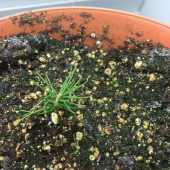posted 2 years ago
But how do you plant trees from seed outdoors?
"Go away!"
"Yes, your Highness. How shall we go away, your Highness?"
There are a few factors I don't quite know how to handle, and some I've figured out but there might be better solutions.
Marking where you put them--just a plastic sign won't do it. I would put a circle of hardware cloth, to protect a bit and to be an unmistakeable, universal sign for "there's supposed to be something here, don't cut it down." I could also see just marking the spot with stones, but that isn't quite as definitive and I might accidentally step on it still. A whole buttload of stones might be required.
Rodents--they do like their seeds. I would gladly apply some Holzer bone sauce...only I do not have any Holzer bone sauce. So, I am thinking some Livestock Guardian Dog influence may help things here, but I don't know for sure if his influence will really protect seedlings.
Deer--I'm pretty sure they won't want to be around Rudolf either. Hm. I don't have truly deer-proof fencing, but it's enough that a deer has to make a decision to hop it and get into Rudolf's domain. (Rodolf is not related to any reindeer, lest there be any confusion. Unless he is what he eats...)
Babying/greenhouse super-season-extension--I think just the microclimate creation will be all it gets, and then other than that it's STUN (sheer total utter neglect). Side-note--I was disappointed that Mark Shepard's advice to pepole wanting ot plant a chestnut tree was to start it in a plastic bucket with hardware cloth, I don't know if this is what he means by STUN, gotta read his book, but I wouldn't call that total neglect, I would call that at least 3.99 of plastic, $1 hardware cloth, some labor digging it in, etc.
I really really like un-planting (see my thread on un-planting black walnuts) but the only trees unplanted here are oaks. Which are Oak A., but I want more of them, everywhere all at once, especially in the paddocks, and they were only starting up in the area that already has a bunch of trees (kinda an ornamental conifer savannah area).
N-fixers--I have planted a few honeylocusts, still not sure what the jury has decided about their n-fixing capacities but the Permaculture Orchard farm seems to be working well and I just have a good feel about honeylocusts, plus Mollison used them in one reclamation project. At any rate, I am going into a field that has had alfalfa and still will have a lot of it, but needs a lot more diversity. I have put in some radish and fodder grains and buckwheat, for starters, but if I plant a whole lot of support species from seed, no way I'm marking each one with hardware cloth.
Any more thoughts on how to implement this?
Lastly, if you were going to use some seedlings to help jumpstart and cull them later, which species would you focus your funds on?
Community Building 2.0: ask me about drL, the rotational-mob-grazing format for human interactions.

 3
3




 1
1




 4
4




 1
1





 3
3




 6
6









